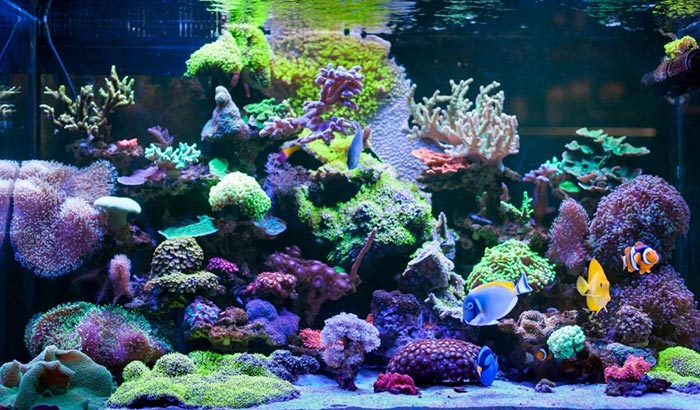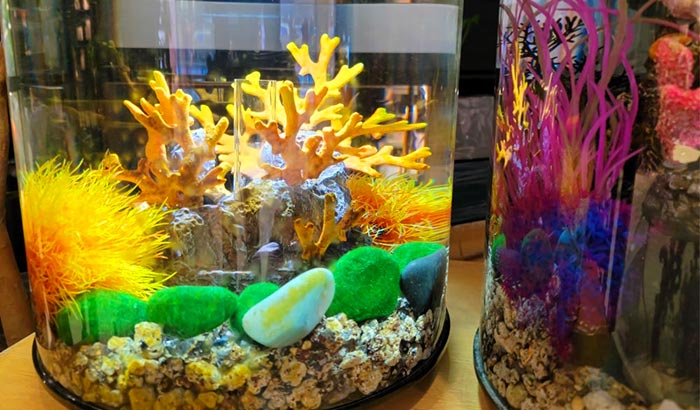If you own a reef tank, phosphate can always be a hot topic because it can be substantial to many fishes in your reef tank. However, inorganic phosphate comes from fish waste, coral slime, leftover food, and dead algae cells can negatively impact your aquarium.
When kept in a higher concentration, Phosphates can help contribute to algae growth and have a negative impact on corals. For this reason, it is essential to learn how to lower phosphate in reef tank to prevent all the adverse effects it brings once uncontrolled.
Contents
Step-By-Step Guide in Lowering Phosphate in a Reef Tank
There are many recommendations when it comes to the ideal phosphate levels in your reef tank. But actually, the right level will be depending on the tank you have. Every reef tank is different from one another.
If your coral is consistently growing while your nuisance algae are under control, the level should have no issue in your aquarium. However, if you have an algae problem, you can lower the phosphate and check how your reef tank will respond.
The idea is to try to level down the phosphate to where the algae are inhibited. Then, you will need to try to maintain the phosphate on the level. You can use different types of testing kits to know the phosphate level of your aquarium.
To lower phosphate levels in your fish tank, there are things that you can do to help during the maintenance of your aquarium. Please check on our step-by-step guide below:
Step 1: Do Water Change
You can do water changes consistently to help reduce the phosphate level of your aquarium. However, this is only a temporary solution if you cannot control the other phosphate sources in your reef translate. Nevertheless, this step should be a good start.
In addition, you cannot rely on changing the water alone to help lower the phosphate. It is because it enters the reef tank at a much faster rate than the constant water change can remove it.
Step 2: Avoid Overfeeding
You can also avoid overfeeding your fish to prevent the phosphate level from going up. Overfeeding your fish may lead to the buildup of uneaten fish food that can decay later. Once it decays, it can produce chemicals and help in making the phosphate level goes up.
Step 3: Use an Effective Protein Skimmer
Using a high-quality protein skimmer at all times will remove organics before it breaks down into phosphate. A protein skimmer will strip out the organics before they can release phosphate into the water.
An efficient skimmer will remove, dissolve, and particulate organic matter. Doing this action will also improve the quality of water in your fish tank while also helping in limiting the phosphate and nitrate levels of your aquarium.
Step 4: Adding a Natural Filter (Optional)
If you still have space, adding a natural filter in your fish tank is also effective in lowering down phosphate levels. A natural filter such as refugium or turf algae scrubber is an excellent way to control phosphate levels in the reef tank.
A refugium with macroalgae will remove phosphate, nitrate, and other nutrients using the fast-growing macro-algae. Chetamorpa is the most popular species of macroalgae, but there are also other options such as Caulerpa and Gracilaria.
Step 5: Check the Water Source and Have a RODI System at Home
Your water can be an excellent source of phosphate in the reef tank. So, you must make sure that your water source does not come with a very high level. You can choose to change the water source and look for something with a low phosphate level.
Otherwise, you can install a RODI system in your home. This system will remove harmful impurities, including phosphate, so that you can make sure that the source of your water is clean and free of contaminants, including phosphate.
Other Methods to Lower Phosphate Level in Reef Tank
Another method to lower phosphate levels in a reef tank is to use filter media to reduce them. These chemicals are best used when the phosphate levels continue to be a problem in your reef tank. Check on these methods below:
GFO (Granular Ferric Oxide)
The GFO will bind inorganic phosphate as water flows through the media. There are many different brands of GFO available in the market. This filter media works slowly and is best used inside a fluidized media reactor to maximize the exposure of the filter media.
Seachem PhosGuard
This filter media comes with a fast-acting alumina oxide which helps in absorbing phosphates. This product is fast-acting and is best used passively inside a media bag or even a canister filter.
Lanthanum Chloride
This chemical comes in liquid form, which is applied directly into the tank. The lanthanum binds with phosphate, which will form microscopic and soluble lanthanum phosphate particles, which will be removed through mechanical filtration and protein skimming.
Combining GFO media and Lanthanum Chloride
A unique but clever approach used by many fish tank owners in learning how to reduce phosphate in an aquarium is combining GFO media and lanthanum chloride. The lanthanum chloride liquid will be used to drop the high level of phosphate to an acceptable range. The GFO media will then be employed to keep it within this range.
As a reminder, a drastic change in the phosphate level will stress out your fish and the corals in the reef tank. A reef tank that is already accustomed to high levels of phosphate is very sensitive. So, make sure to test your water carefully while dropping your level slowly over time.
Choosing the correct phosphate control method should be aimed specifically at your tank’s needs. The priority is to limit phosphate entry of your aquarium, as discussed by our step-by-step guide. When the level continues to be a problem, you can only use the chemicals we mentioned earlier.
I also suggest reducing your stocking levels while improving your filtration system to help maintain an acceptable phosphate level of your reef tank. Relying on chemicals can be expensive and can bring other negative impacts to the reef tank.
Conclusion
There is no doubt that phosphate is essential to your reef tank. But it should be kept at low levels every time. For this reason, it is necessary to learn how to lower phosphate in reef tank to avoid complications in the future.


